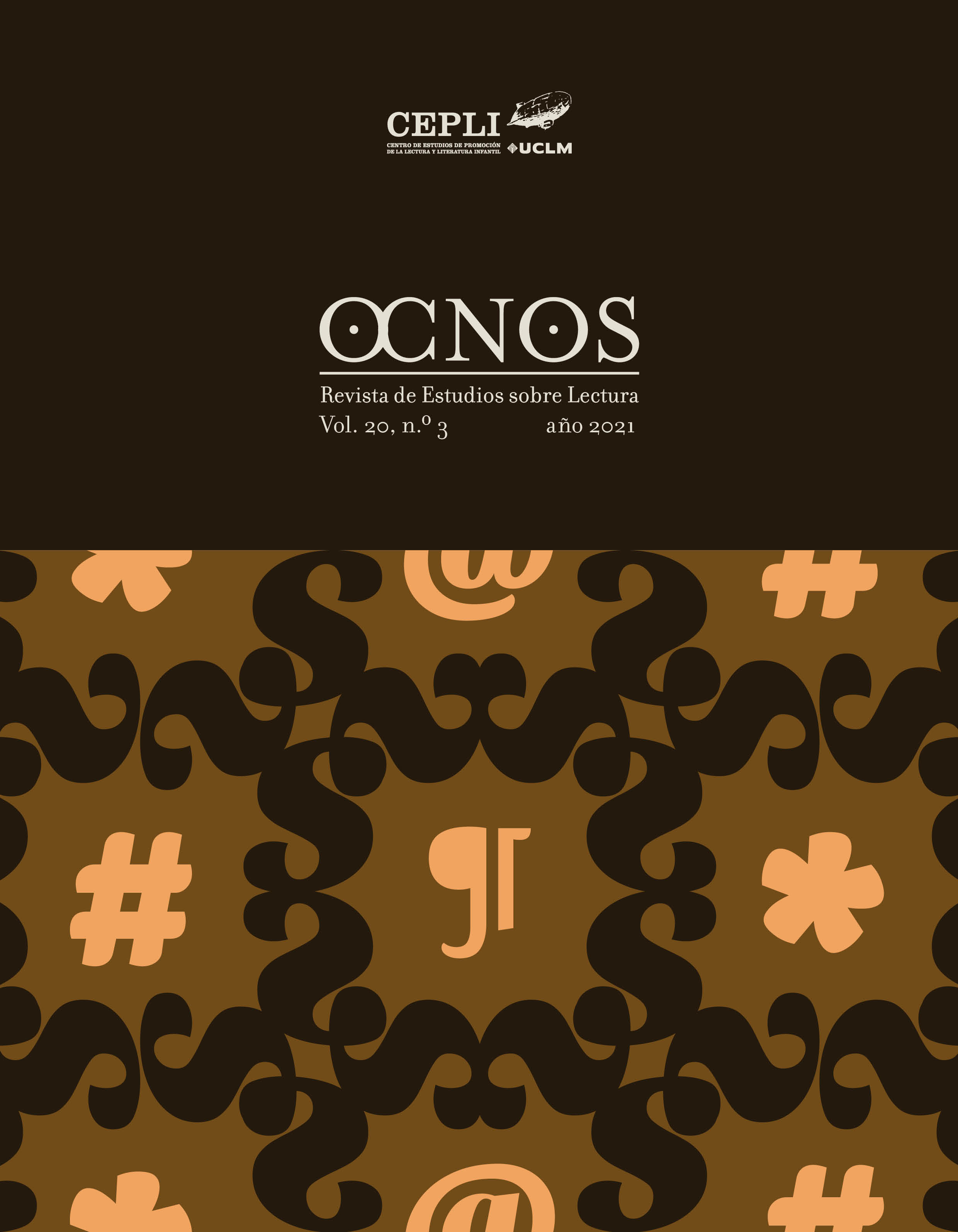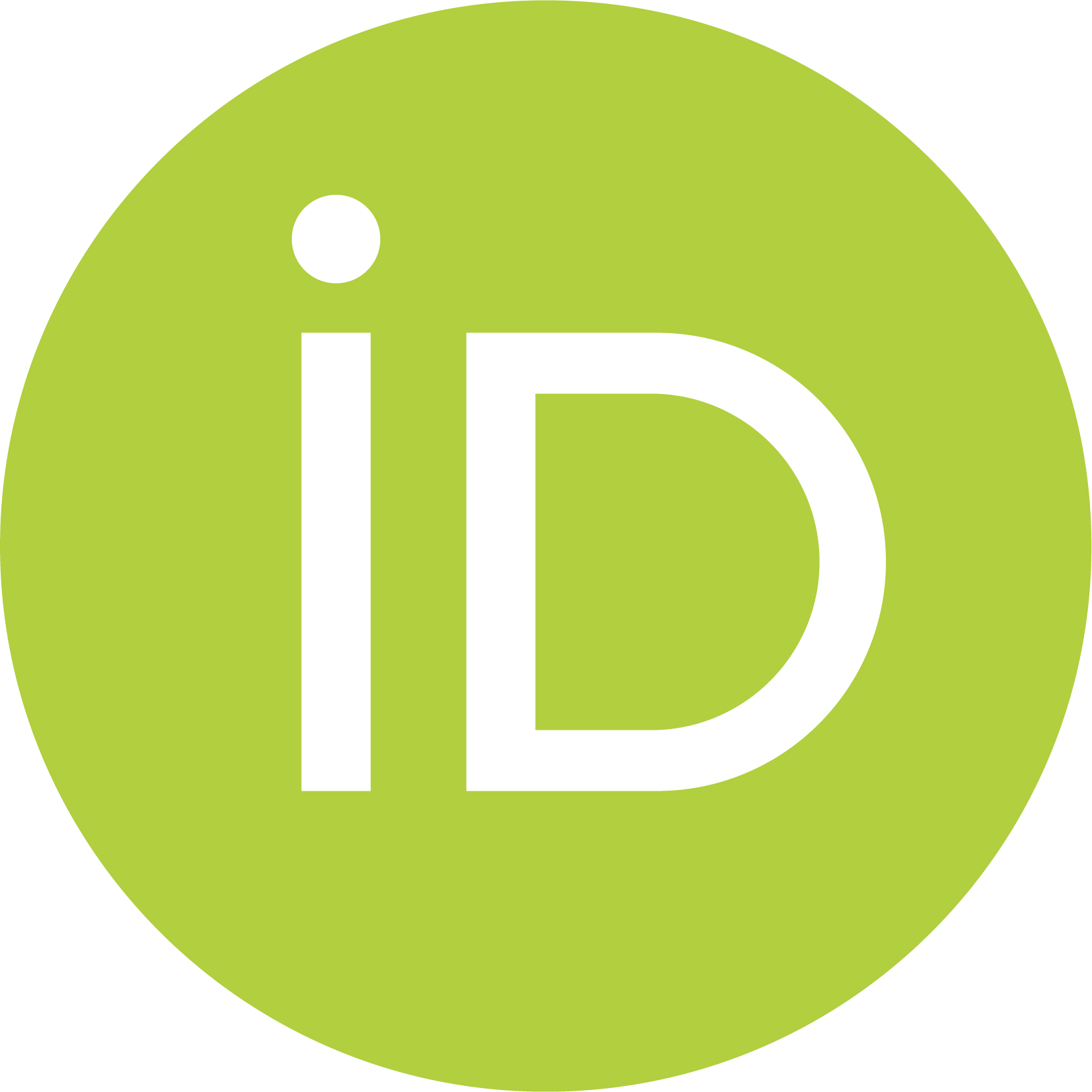Introduction
Information and Communication Technologies (ICTs) have transformed the reading experience and a recomposition of written culture can thus be noted globally (García-Canclini, 2015). The school, the teacher and the family still are key figures for the promotion and initiation of reading in the early years of education (Gil-Flores, 2009; Munita, 2014; Granado, 2014); however, the traditional role of these social institutions has suffered an impact with ICTs and the growing use of social networks, especially among adolescents and young people. A diversification in the channels of access, communication and reading participation is emerging as part of such changes.
In 2010, Gemma Lluch announced how school libraries were surpassed as intermediary institutions that regulated what is read and began to observe the paratexts that arise as a result of young population reading blogs and virtual communities. In Lluch’s subsequent research (2012; 2014), new intermediaries appear, such as bloggers, fans and booktubers, who are promoting other ways of reading, writing, participating and interacting socially based on the act of reading. One of the main characteristics of these scenarios is that they have facilitated the consolidation of an active receptor that transforms the reading experience into the production of diverse content, thus building an open, horizontal and more democratic relationship between authors, publishers and readers (García-Canclini, 2015; García-Roca, 2016).
In this interaction with Web 2.0, Hernández-Hernández et al. (2018) argued that “ICTs are everywhere and it is impossible to talk about learning, teaching or education without them” (p. 18). Cassany (2015) explains that the learning experience nowadays arises not only between the classroom or the Virtual Learning Environment (VLE) of the subject in question, such as Moodle or institutional platforms, but there is also a Personal Learning Environment (PLA) made up of virtual groups that access and exchange information from the inexhaustible resources of the internet. This communication directly influences the classroom experience, even when the teacher is outside the PLA. Therefore, the researcher constantly calls to leverage this current educational context, since “ignoring what our students do with social networks not only prevents us from leveraging of them to learn, but also contributes to distancing our class from their daily practices” (p. 204). This is not a minor issue, according to Inés Dussel (quoted in García-Canclini, 2015), the gap between traditional practices and those of Web 2.0 means that young people find themselves between a double legitimacy: that of school and that of the world of social networks.
Therefore, delving deeper into these transformations allows us to reconsider the challenges entailed in the formation of reading audiences inside and outside educational institutions and to contribute to closing the gap between traditional practices and the social interaction fostered by Web 2.0. The majority of the higher education population is made up of 18–25-year-olds who share generational practices and respond to similar current challenges, including new forms of consumption mediated by technology. In this sense, studies on reading practices and habits provide valuable information to promote a favourable generational attitude towards reading and, based on the results, to create educational approaches that respond to the needs of the new readers who inhabit classrooms (Granado, 2014).
This article analyses reading practices among university students of different disciplinary profiles with the aim of getting to know and approach the ways in which young people read and share reading in our times. The data were collected as part of the reading activation programme known as “Livraria. Encuentro de lectores y no lectores”, which received funding from the Fondo Nacional para la Cultura y las Artes de México twice consecutively from 2017 to 2019 for the creation and implementation of a reading programme within the Universidad Autónoma de Yucatán, Mexico, in two of its areas of knowledge: the Campus of Social and Economic-Administrative and Human Sciences, (CSEAyH), and the Campus of Exact Sciences and Engineering (CEI). The results obtained are intended to support reading activation strategies under new formats and other ways of reading in the university world and to contribute somehow to the debate on reducing the gap between the formal sphere and the spaces that young people access for pleasure to share their reading.
The university and its readers
Studies of reading habits in higher education students agree that students do not lack reading habits, and are even considered frequent readers who consume a wide range of texts (Salvador-Oliván & Agustín-Lacruz, 2015; Cornejo et al., 2012), but they point out that this practice is reduced in several ways at the same time, such as: 1) instrumental reading, which is mainly linked to an extrinsic motivation such as covering the compulsory reading of the subjects for the completion of a specific task (Larrañaga et al., 2008; Cornejo et al., 2012; Granado, 2014); 2) when there is an intrinsic motivation, we find a homogenisation and standardisation of reading centred on the best sellers of the time (Munita, 2014); 3) studies point to an urgent need for training and promotion of an approach to reading of their own free will (Larrañaga et al., 2008; Yubero & Larrañaga, 2015; Fernández-Blanco et al., 2017); especially if the population are teachers in training, it is noted that they would not be able to motivate their future students towards a reading habit that they lack (Applegate et al., 2014; Granado, 2014; Munita, 2014; Caride et al., 2018).
This way, it has been recognised that there is a prevalence of instrumental readers among university students, understood as those who “perfectly decode written language to access information, but who do not read on a regular basis, nor does reading form part of their leisure time” (Larrañaga et al., 2008, p. 4). Instrumental reading is notoriously present during university studies and constitutes a requirement for any subject, since it is the traditional way of acquiring information and - as mentioned above - it is related to an external requirement (Fernández-Blanco et al., 2017). One of the risks of instrumental reading is that, at the end of the compulsory relationship, condition or external stimulus, the student lacks a consolidated reading habit or reasons of his or her own to continue reading.
On the other hand, Fernández-Blanco et al. (2017) distinguish another type of reading, reading for pleasure or entertainment, which is a genuine cultural activity that involves consumption and social interaction among peers, and which is promoted from various spheres such as academia, cultural activities and the market. However, this type of reading has not shown up strongly in studies of reading habits among university students. The study by Yubero and Larrañaga (2015) with 2,745 university students in Spain and Portugal concluded that only 55% of the population can be considered frequent readers: 25% read, but do not recognise reading as a lifestyle, 16% of Spanish and 12% of Portuguese students never or almost never read, and 8% have not read any book in the last year. Caride et al. (2018) agree and confirm the low rates of frequent readers among university students, where only 29.1% considered themselves readers in a study of 733 trainee teachers. Researchers warn that it is wrong to assume that students read at university when they do not have a strong habit of reading as a daily and social practice. They conclude by emphasising the need for the university, the library and extension services to create programmes that help promote reading for pleasure and of one’s own free will.
Yubero and Larrañaga (2015) and Caride et al. (2018) insist on this fact in the findings of studies of reading habits among university students. The challenge facing higher education institutions is to generate - alongside the instrumental reading of each subject - reading programmes with a socio-cultural, creative and comprehensive approach where genuine interest is fostered simply for the delight generated while living with the text (Aranda-Barradas, 2009; Granado, 2014; Applegate et al., 2014; Yubero and Larrañaga, 2015; Fernández-Blanco et al., 2017; Caride et al., 2018).
Reading for pleasure
Reading research is evolving rapidly due to a proliferation of purposes and modalities that the internet and digital texts have brought to the scope of the traditional printed book (Putro & Lee, 2018). In this sense, alongside studies on reading habits, there is a growing corpus that shows how out-of-school contexts foster the emergence of reading pleasure (Caride et al., 2018) where social networks are increasingly linked to a free, voluntary and communal reading practice and production where readers explore their creative skills (García-Roca, 2016) such as, for example, booktubers (Paladines-Paredes & Margallo, 2020); bloggers (Lluch, 2012) and young writers who publish their work on a reading and writing network such as Wattpad (García-Roca & De-Amo, 2019).
This type of reading focuses its definition on an act of freedom and self-determination; that is, the reader freely turns to reading material in his or her leisure time, for fun or personal well-being, rather than as an external requirement or school duty (Dezcallar et al., 2014). Putro and Lee (2018) found that current readers in university classrooms read in multiple modalities, and link print reading to academic purposes; while social media reading is closely linked to recreation and belonging to social communities. Mokhtari et al. (2009) reported that 95% of young university students use the internet on a daily basis and 32% read for recreational purposes on a daily basis in a study of 539 university students. A multitasking profile is consolidated that combines academic reading, voluntary or recreational reading, consumption of audiovisual materials, information search and interaction with virtual social networks at the same time (Mokhtari et al., 2009; Cortés-Campos, 2015).
The recognition of the link between Web 2.0 and practices associated with voluntary reading and diversification of forms of participation enables educational institutions to recognise didactic contributions and dynamise reading models (Paladines-Paredes & Margallo, 2020); to leverage the creative and collaborative momentum of students in virtual communities (García-Roca & De-Amo, 2019); and to somehow achieve a greater link between reading and leisure time in formal settings (Caride et al., 2020). Added to this is the emphasis on the competences pursued in the higher education system, where creative, critical and oral and written communication skills are listed as generic competences in accordance with the Tuning América Latina project.
This study deals with the reading practices of young university students and analyses the patterns and groupings that occur among students of different disciplinary profiles that help to establish diverse and appropriate reading models for the context of Web 2.0. The study approach follows Cassany’s (2015) vision that “emphasises the social and everyday nature of reading and writing, integrated in other community practices, whether spoken, non-verbal or multimodal” (p.190); therefore, it goes beyond the idea of studying reading habits linked to the printed book only and privileges the different ways of coexisting and interacting socially with reading instead. For this purpose, the methodology proposed by the Regional Centre for Book Development in Latin America and the Caribbean (CERLALC, 2014) was followed, as it is specifically created with the aim of analysing new scenarios, the variety of devices, hybrid and transmedia production practices that are linked to reading and which, in turn, point to emerging reading skills.
The CERLALC (2014) argues in favour of a plurality of reading practices that go beyond the idea of looking at reading in terms of the number of printed books read per year. It unveils the hybrid character of reading practices that mix modalities, different platforms and narratives that facilitate other forms of artistic, creative and cultural expression. The point of contact between different media and languages leads the reading to situate itself in transmedia scenes: “The exchange of narratives, languages and media, characteristic of a transmediatisation of reading, translates into a complexification of social practices, which warns of the need for different and more integrative ways of measuring compartments” (p. 27). According to Scolari (2018), this scenario favours transmedia literacy, where the traditional consumer becomes a prosumer, i.e., an active subject who creates new content and circulates it through social networks. As part of this level of literacy comes the recognition of competencies in production, remixing, intervention and participatory skills (p. 16). For the CERLALC (2014), this can be found in a reading and writing exercise that does not have a single objective or purpose, but responds to a diverse nature: sometimes to spaces of collaborative-production such as fanfiction; or of autonomous-production such as a personal blog or a tweet; as well as of a communicative nature such as an email; among others (p. 27).
Method
As for the scope of the research, it is stated it is based on a positivist paradigm, due to the fact that the researcher recognises a reality that is independent and capable of being measurable; it has a quantitative focus due to the use of numerical data and statistical analysis techniques; and it is exploratory in scope due to its interest in examining a subject that has not been studied very much (Hernández-Sampieri et al., 2006).
The methodology used in the research based on the quantitative data provided is called Knowledge Discovery from Dataset (KDD), which is defined as the non-trivial process of identifying valid, novel and potentially useful and ultimately understandable patterns from the data (Fayyad et al., 1996). The KDD implemented in this research has five stages:
-
Selection, this activity is the integration and collection of the sources of information to be used in the research. For the purposes of this study, the questionnaires applied to students at the CSEAyH and CEI campuses were used.
-
Pre-processing is the refinement of the selected information. This was the most complex stage due to the analysis of the most relevant items for the study, as well as the correction of the data.
-
Transformation is the preparation of data into a format that facilitates portability and use for the application of data mining algorithms.
-
Data mining is the application of algorithms (classification, clustering, association, among others) and the method to be used is chosen depending on the knowledge needs or interests.
-
Interpretation refers to the analysis and comparison of the results obtained.
Population
The population consisted of a representative sample of two areas of knowledge from Universidad Autónoma de Yucatán. In the case of the CEI Campus, the population amounted to 289 (179 men and 110 women) students, mainly between 18 and 21, belonging to the Faculties of Engineering (38.4%), Chemical Engineering (27%) and Mathematics (32.5%). In the case of the CSEAyH Campus, 378 students (191 women and 187 men) were surveyed, mainly between 18 and 21, of whom more than 50% belong to the Faculties of Law and Accounting and Administration, and the other 50% to the Faculties of Education, Anthropological Sciences and Economics.
Instrument
The instrument used in this study is an adaptation of the questionnaire provided by the CERLALC methodology (2014), which contains 24 items, of which 6 were intended to identify the socio-demographic characterisation of the participants; the remaining 18 addressed the variables of:
The form allows “cross-referencing of a considerable number of variables to target the population with standard indicators” (CERLALC, 2014, p. 40). For the purposes of this study, items were identified that link the reading practices of the population with “hybrid and transmedia consumption scenarios” (p.19), where the variety of narratives, languages, platforms and supports that complexify and diversify the reading and writing practices of the ICT-mediated context are considered.
Ethical issues
The students participated on a voluntary basis, gave their informed consent and the anonymity of their responses was guaranteed.
Results
As for the descriptive results, it stands out that book reading is associated with a series of complementary activities that accompany the user experience. The following graphs illustrate this issue:
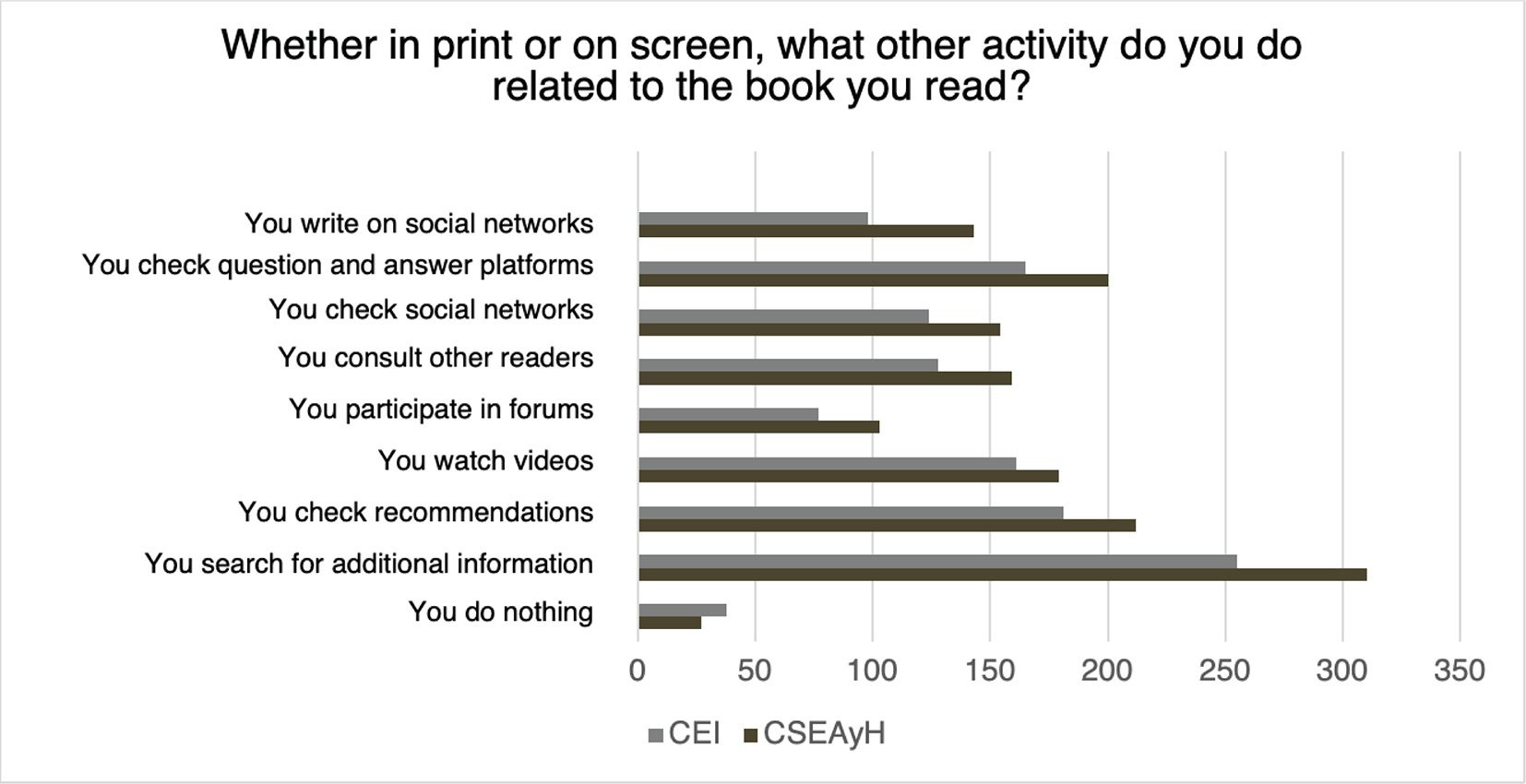 Figure 1
Complementary activities you do with the books you read
Figure 1
Complementary activities you do with the books you read
Source: Prepared by the authors.
According to figure 1, the search for complementary information to what is being read is the main activity carried out by both groups: 8.9% (n=255) of the CEI and 84.2% (n=310) of the CSEAyH Campus ranked this as the most recurrent activity that accompanies their reading. Other relevant activities in this category are the consultation of recommendations and question and answer platforms. In addition to the above, both groups reported a very low percentage of no action related to what they read: 13.2% (n=38) in the CEI 7.3% (n=27) in the CSEAyH. This category entails an active role, as the reader must react, respond or generate his or her own discourse based on reading in ICT-mediated scenarios.
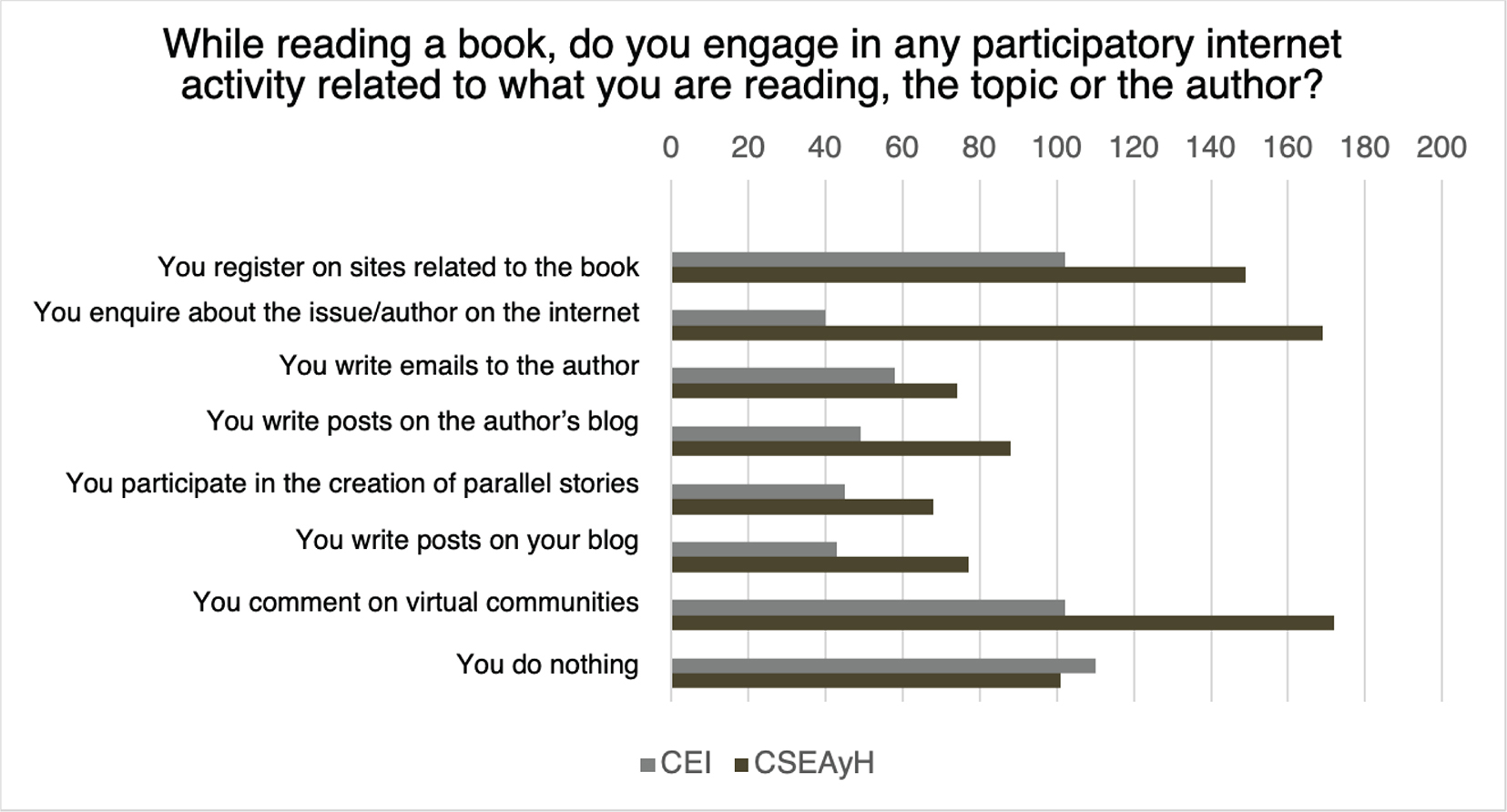 Figure 2
Participatory internet activities linked to the book read.
Figure 2
Participatory internet activities linked to the book read.
Source: Prepared by the authors.
According to figure 2, the main participatory activities on the Internet linked to what is read are: feedback in virtual communities where 38.2% (n=102) and 48.3% (n=172) of the CSEAyH stated they take part in this activity; with a very close interest 39.7% (n=106) of the CEI and 47.5% (n=169) of the CSEAyH sign up to sites related to the book. As for activities involving a creative writing production role, 19.1% (n=68) of the CSEAyH reported participating in these activities, while the CEI had a lower percentage of 16.9% (n=45). It is also noteworthy that the proportion of students who do not have any activity in digital media was notoriously high in the CEI group with 41.2% (n=110) compared to 28.4% (n=101) in the CSEAyH.
In a second stage of the study, data mining techniques were implemented, which consist on extracting information to generate knowledge that can be expressed through concepts, rules, laws, patterns, among others (Chen, 2006). According to Hernández-Ollado et al. (2004), learning models used in data mining can be divided into two main categories: predictive or supervised learning (including classification and prediction algorithms) and descriptive or unsupervised learning (including clustering, association, correlation and dependency algorithms). In this research, due to the nature of the data, we experimented with classification and clustering algorithms using the freely distributed software WEKA (Waikato Environment for Knowledge Analysis) version 3.8 developed by Witten and Frank (2002).
Regarding the experiment with classification algorithms, it is noted that they are used to classify data, in order to predict classes of objects whose categorisations have not been defined. The NaiveBayesSimple algorithm developed by Chandra et al. (2007) proved to be the most efficient one for the database. The reading practices of university students at the CEI and the CSEAyH were compared. The rules obtained are described below:
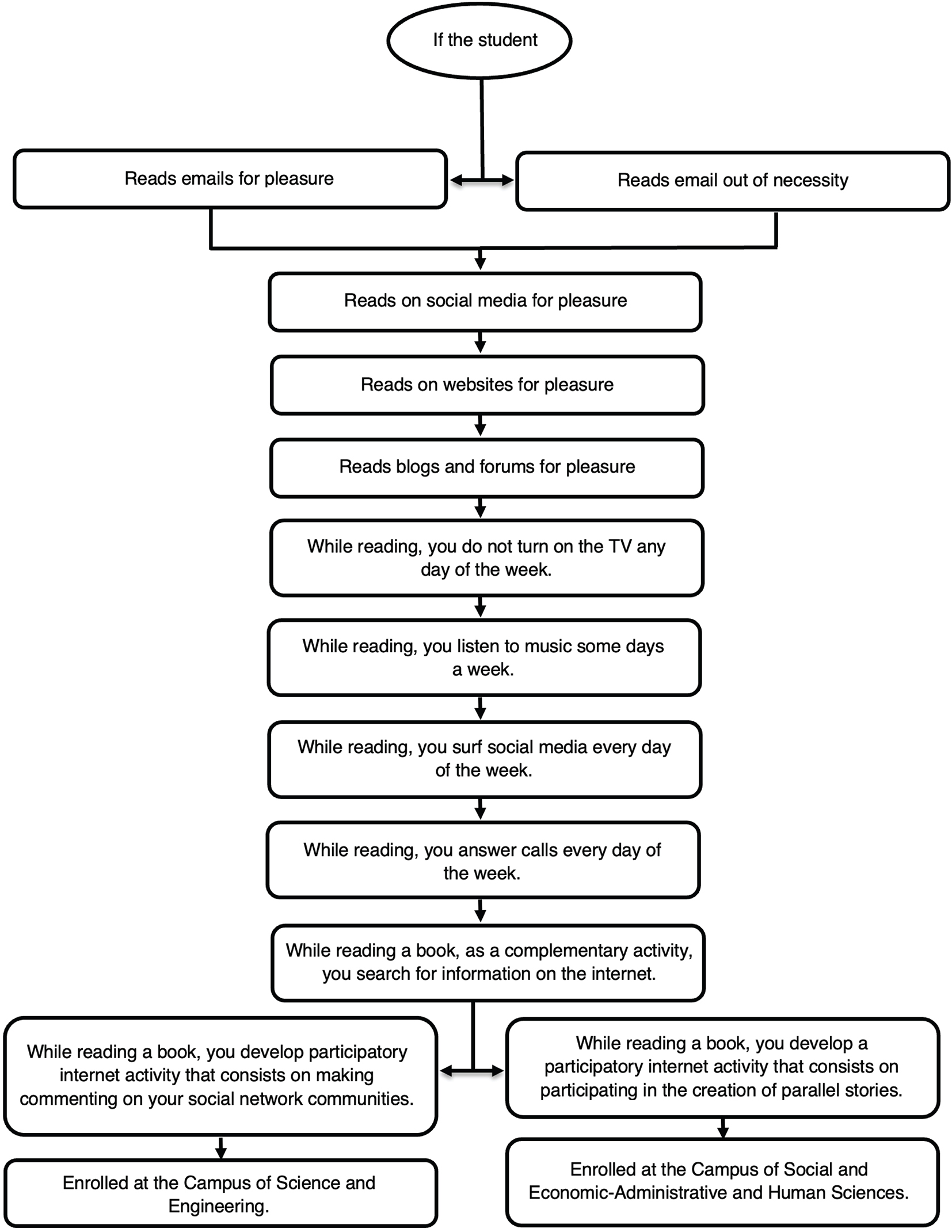 Figure 3
Knowledge rules generated by the NaiveBayesSimple classification algorithm through the software
Figure 3
Knowledge rules generated by the NaiveBayesSimple classification algorithm through the software
Source: Prepared by the authors.
As can be seen in figure 3, the rules generated are of the type if /then/else, which represent the trends found among the students enrolled in both Campuses analysed, among which the following stand out: a taste for reading in digital environments, a lack of interest in watching content on television, the daily frequency with which they carry out actions such as browsing social networks and the use of mobile devices. On the other hand, their behavioural differences are evident, such as: reading emails and engaging in activities on the internet while reading a book.
As for the experiment with clustering algorithms, it stands out that they do not require a predefined classification to partition the data, obtaining knowledge according to the characteristics of the data. The SimpleKMeans algorithm developed by MacQueen (1967) was the most efficient one. The results are described below.
Table 1
Groups generated by the SimpleKmeans algorithm using WEKA software
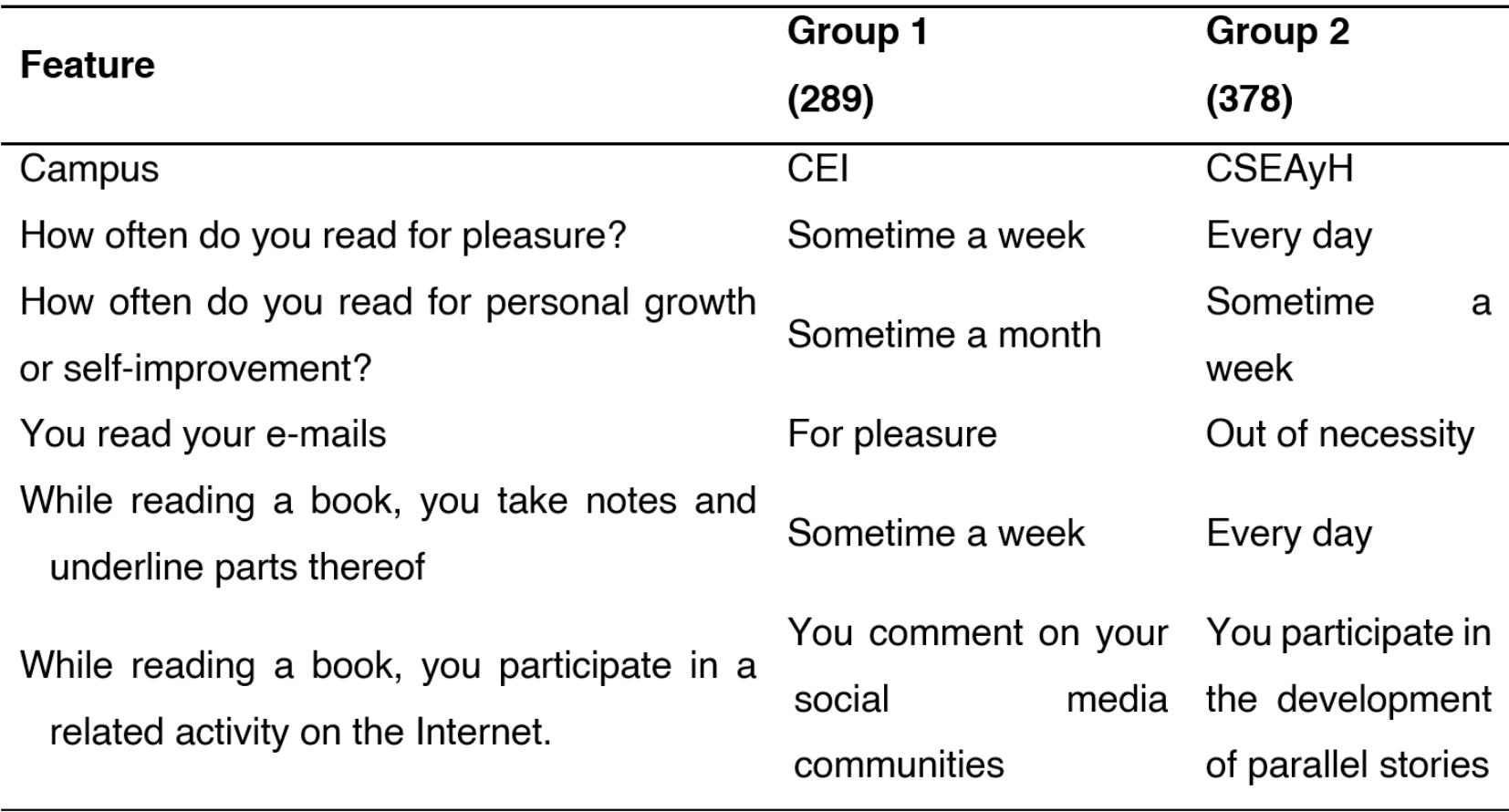
Source: Prepared by the authors.
Table 1 shows those features whose values or labels were found to be mutually exclusive, i.e., those values that are found in one group only. Differences are marked in the frequency with which they read for pleasure or pleasure, readings related to their personal growth and their respective notes. In addition, the difference of opinion is confirmed with regard to e-mails and the development of different activities on the Internet linked to reading while reading a book.
Discussion
With regard to the groupings of the study population according to the Campus of origin, it was found that both groups have similar characteristics in common such as reading for pleasure in various digital formats, including social networks, blogs, forums and websites. This is in line with Cassany (2015), who stated that alongside instrumental reading, young people construct a Personal Learning Space (PLS) where they consult websites and interact on social networks that turn out to be an extension of institutional platforms. The importance of including these scenarios in teaching strategies lies in the fact that they are spaces where young people go for pleasure and, according to Granado (2014), García-Roca (2016) and Paladines-Paredes and Margallo (2020), they would help to create other models of teaching reading that are more appropriate and relevant for the current generations who are in the process of training.
In addition to the above, within the characterisation of the resources and platforms used voluntarily, it is worth noting that this choice falls within the immediate social interaction that the Web 2.0 context allows, leaving out supports that mainly indicate a consumption activity such as e-mail and television. García-Canclini (2015), García-Roca (2016) and Scolari (2018) have been emphatic in indicating that one of the most significant transformations of current reading practices is the possibility of mutating from the role of passive consumption to one of production. In such a way that the current generation of young people will tend to reject media that do not allow spaces for responses, interactions, and immediate interventions that enable the mutation from a role of reception to one of production. For CSEAyH students, email is located within reading that is fulfilled out of necessity or requirement, unlike social networks, which both groups use for pleasure on a daily basis, and which are characterised by the interactivity they allow instantaneously.
Similarly, the CERLALC (2014) announces that reading is increasingly related to various platforms and transmedia scenarios that are changing this social practice. These include linking the action of reading to e consultation of complementary information, participation in forums and the publication of messages on social networks. The university students in the study group confirm that while reading they are connected to multiple devices that allow them to listen to music, answer calls, send messages and search for information complementary to what is being read. The reading scenario is thus carried out by young people who are interconnected through multiple devices that are used at the same time for multitasking, where social networks are gaining prominence, as pointed out in the studies by Mokhtari et al. (2009), Cortés (2015) and Putro and Lee (2018).
However, both groups primarily comment on their social network communities as a way of responding or reacting to what is read in terms of participatory internet practices related to reading. The CSEAyH group acknowledges participating in parallel story writing, i.e., they generate creative writing that makes them co-creators. In accordance with the above, (García-Roca, 2016), Lluch and Acosta (2012) and García-Roca and De-Amo (2019) have given examples of how creative writing emerges as an extension of the act of reading. The behaviour pattern of the CSEAyH group confirms they are young people who coexist with reading and writing as practices based on a single synergy that complements them, i.e., reading is only the beginning for the creation of their own stories. However, creative production behaviour is not generalised for both profiles, which is an important area to analyse and encourage.
The frequency of recreational or wilful reading is another difference between the two groups. Reading for pleasure is present on a daily basis among CSEAyH students, who are the group with the highest production role. While the CEI group, which enjoys reading for pleasure at a lower frequency, plays a role of responding and reacting on the internet to what they read, but does not complete the producer profile. In other words, the creativity competence pursued in the generic competences of higher education is closely related to reading for pleasure. Studies of reading habits consistently conclude the importance of promoting this type of reading linked to intrinsic motivation and overcoming an initial relationship with reading as an act of comprehension or knowledge acquisition within educational institutions (Yubero & Larrañaga, 2015; Caride et al., 2018).
It is concluded that today’s generation of young people interacts with ICTs on a daily basis, in both formal and informal settings, which has transformed traditional practices and roles around reading. One of the strengths of the Web 2.0 scenario is that participatory practices linked to reading invite young people to interact in more democratic active roles where their voice and ideas also have the right to be read and heard. However, this role is not yet shared equally by students associated with different disciplinary profiles. Therefore, an in-depth knowledge of current reading and writing practices has enormous potential for the constitution and promotion of reading and creative writing training programmes within universities that consider different media and platforms with the aim of rethinking what reading implies and how this act involves creative responses, reactions and interactions now more than ever.
One limitation of the study is that it is limited to two disciplinary groupings. It is recommended for future research to extend the study population to other disciplinary fields such as health sciences or biological sciences in order to complete a generational picture of the disciplinary profiles that coexist at universities.
Similarly, researchers are grateful for the support provided to the Fomento a Proyectos y Coinversiones Culturales del Fondo Nacional para la Cultura y las Artes (FONCA) Programme of Mexico for the diagnosis of reading practices of the Livraria 2017-2019 programme, which allowed the design, implementation and evaluation of reading strategies in two campuses of the Universidad Autónoma de Yucatán.
References
Applegate, A. J., DeKonty-Applegate, M., & Mercantini, M. A. (2014). The Peter Effect Revisited: Reading Habits and Attitudes of College Students. Literacy research and instruction, 53(3), 188-204. https://doi.org/10.1080/19388071.2014.898719
Aranda-Barradas, J. S. (2009). Mimesis y metamorfosis en el acto de leer. Innovación educativa, 9(49), 5-10.
Caride, J. A., Caballo, M. B., & Gradaílle, R. (2018). Leer en tiempos de ocio: los estudiantes, futuros profesionales de la educación, como sujetos lectores. Ocnos, 17(3), 7-18. https://doi.org/10.18239/ocnos_2018.17.3.1707
Cassany, D (2015). Redes sociales para leer y escribir. In G. Bañales, N. Vega, & M. Castelló (Eds.), Enseñar a leer y a escribir en la educación superior: manual de buenas prácticas basadas en la investigación (pp. 187-208). Editorial Universidad Autónoma de Tamaulipas.
CERLALC. (2014). Metodología común para explorar y medir el comportamiento lector. El encuentro con lo digital. UNESCO, CERLALC. https://bit.ly/3dUJsmW
Cornejo, J. N., Roble, M. B., Barrero, C., & Martín, A. M. (2012). Hábitos de lectura en alumnos universitarios de carreras de ciencias y tecnología. Eureka, 9(1), 155-163. https://doi.org/10.25267/Rev_Eureka_ensen_divulg_cienc.2012.v9.i1.11
Cortés-Campos, R. L. (2015). Uso y consumo de redes sociales virtuales entre estudiantes universitarios. Un acercamiento a los hábitos de multitarea. Revista Iberoamericana de Producción Académica y Gestión Educativa, 2, 1-16.
Chandra, B., Gupta, M., & Gupta, M. P. (2007). Robust Approach for Estimating Probabilities in Naive-Bayes Classifier. In International Conference on Pattern Recognition and Machine Intelligence (pp. 11-16). Springer. https://doi.org/10.1007/978-3-540-77046-6_2
Chen, A. (2006). The Technology and Application of Data Mining. Science Press.
Dezcallar, T., Clariana, M., Cladelles, R. Badia, M., & Gotzens, C. (2014). La lectura por placer: su incidencia en el rendimiento académico, las horas de televisión y las horas de videojuegos. Ocnos, 12, 107-116. https://doi.org/10.18239/ocnos_2014.12.05
Fayyad, U., Piatetsky-Shapiro, G. & Smyth, P. (1996). From Data Mining to Knowledge Discovery. AI magazine, 17(3), 37–54.
Fernández-Blanco, V., Prieto-Rodríguez, J., & Suárez-Pandiello, J. (2017). A Quantitative Analysis of Reading Habits in Spain. International Journal of Arts Management, 19(3), 19-32.
García-Canclini, N. (2015). Leer en papel y en pantallas: el giro antropológico. In N. García-Canclini, V. Gerber-Biecci, A. López-Ojeda, E. Nivón Bolán, C. Pérez Camacho, C. Pinochet Cobos, & R. Winocur Iparraguirre (Eds.), Hacia una antropología de los lectores (pp. 1-35). Telefónica Fundación, Universidad Autónoma Metropolitana & Ariel.
García-Roca, A. (2016). Prácticas lectoras en espacios de afinidad: formas participativas en la cultura digital. Ocnos, (15), 42-51. https://doi.org/10.18239/ocnos_2016.15.1.979
García-Roca, A., & De-Amo, J. M. (2019). Jóvenes escritores en la red: un estudio exploratorio sobre perfiles de Wattpad. Ocnos, 18(3), 18-28. https://doi.org/10.18239/ocnos_2019.18.3.1968
Gil-Flores, J. (2009). Hábitos y actitudes de las familias hacia la lectura y competencias básicas del alumnado. Revista de educación, 350, 301-322.
Granado, C. (2014). El docente como lector: estudio de los hábitos lectores de futuros docentes. Cultura y Educación, 26(1), 44-70. https://doi.org/10.1080/11356405.2014.908666
Hernández-Hernández, D., Cassany, D., & López-González, R. (2018). Las TIC en los contextos escolares. In D. Hernández- Hernández, D. Cassany, & R. López-González (Coords.), Prácticas de lectura y escritura en la era digital (pp. 15-28). Editorial Brujas.
Hernández-Sampieri, R., Fernández-Collado, C. & Baptista-Lucio, P. (2006). Metodología de la investigación (4th ed.). McGraw Hill.
Hernández-Ollado, J., Ramírez-Quintana, M. J., & Ferri-Ramírez, C. (2004). Introducción a la Minería de Datos. Editorial Pearson.
Larrañaga, E., Yubero, S., & Cerrillo, P. C. (2008). Estudio sobre los hábitos lectores de los universitarios españoles. CEPLI, Fundación SM.
Lluch, G. (2010). Las nuevas lecturas deslocalizadas de la escuela. In G. Lluch (Ed.), Las lecturas de los jóvenes. Un nuevo lector para un nuevo siglo (pp. 105-128). Anthropos.
Lluch, G., & Acosta, M. (2012). Conversaciones sobre lecturas en la Web 2.0: el caso de Laura Gallego. Análisis discursivo de conversaciones virtuales entre adolescentes. In J. Díaz Armas (Ed.), Lecturas para el nuevo siglo: formación receptora y lector hipertextual (pp. 37-52). Servicio de Publicaciones de la Universidad de La Laguna.
Lluch, G. (2014). Jóvenes y adolescentes hablan de lectura en la red. Ocnos, 11, 7-20. https://doi.org/10.18239/ocnos_2014.11.01
Macqueen, J. (1967). Some Methods for Classification and Analysis of Multivariate Observations. In Proceedings of the Fifth Berkeley Symposium on Mathematical Statistics and Probability, 1(14), 281-297.
Mokhtari, K., Reichard, C. A., & Gardner, A. (2009). The impact of internet and television use on reading habits and practices of college students. Journal of Adolescents &Adult Literacy, 52(7), 609-619. https://doi.org/10.1598/JAAL.52.7.6
Munita, F. (2014). Trayectorias de lectura del profesorado en formación. Cultura y Educación, 26(3), 448-475, https://doi.org/10.1080/11356405.2014.965449
Paladines-Paredes. L. V., & Margallo, A. M. (2020). Los canales de booktuber como espacio de sociabilización de prácticas lectoras juveniles. Ocnos, 19(1), 55-67. https://doi.org/10.18239/ocnos_2020.19.1.1975
Putro, N. H. P. S., & Lee, J. (2018). Profiles of readers in a digital age. Reading Psychology, 39, 585-601. https://doi.org/10.1080/02702711.2018.1496502
Salvador-Oliván, J. A., & Agustín La-Cruz, M. del C. (2015). Hábitos de lectura y consumo de información en estudiantes de la Facultad de Filosofía y Letras de la Universidad de Zaragoza. Anales de Documentación, 18(1), 2-15. https://doi.org/10.6018/analesdoc.18.1.201971
Scolari, C. A. (2018). Introducción: del alfabetismo mediático al alfabetismo transmedia. In Adolescentes, medios de comunicación y culturas colaborativas. Aprovechando las competencias transmedia de los jóvenes en el aula (pp. 14-23). Ge.Ge.
Tuning América Latina. Competencias genéricas de América Latina. http://tuning.unideusto.org/tuningal/index.php?option=content&task=view&id=217&Itemid=246
Witten, I. H., & Frank, E. (2002). Data mining: practical machine learning tools and techniques with Java implementations. Acm Sigmod Record, 31(1), 76-77. https://doi.org/10.1145/507338.507355
Yubero, S., & Larrañaga, E. (2015) Lectura y universidad: estudio de hábitos lectores de los estudiantes universitarios de España y Portugal. El profesional de la información, 24(6), 717-723. https://doi.org/10.3145/epi.2015.nov.03
Author notes
* Contact: eloisa.alcocer@correo.uady.mx

